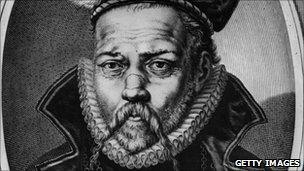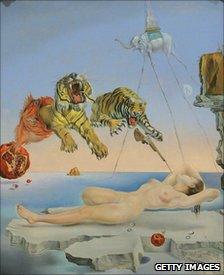Lost in Wikipedia
- Published
Richard Symonds, one of Britain's top Wikipedia contributors, explains why he finds updating the online encyclopaedia so addictive
Wikipedia is celebrating its 10th anniversary and has long been a refuge for those avoiding homework by getting lost in an ever-burgeoning string of tangential morsels of knowledge. But how much can you learn from Wikipedia in one hour?
It's easy to get lost while wandering through Wikipedia.
Perhaps sitting at home one evening, a tax return needs to be filled in, or a new shed picked and ordered. Instead there is a sudden desire to immerse oneself in Wikipedia-aided trivia.
Most trips to Wikipedia start off legitimate, in a genuine effort to garner pertinent information for the task in hand, but then a link catches the eye. Was Matilda genuinely queen of England, external, and what exactly happened in the Milli Vanilli scandal, external?
But perhaps we should celebrate what might be termed wiki-chaining or wiki-crack, depending on one's perspective.

Aristotle was the human Wikipedia of his day
You can learn a lot in an hour on the world's biggest free encyclopaedia.
1000 GMT It seems appropriate to start the journey with Aristotle , externalwho, as his Wikipedia entry notes, was "probably the last person to know everything there was to be known in his own time". He was, in a sense, a classical human Wikipedia.
A huge influence on subsequent philosophical thought, Christian theology and medieval science, Wikipedia notes that his views on the physical sciences were ultimately superceded by Newtonian physics.
1003 GMT Clicking on "Newtonian physics, external" actually takes you to the entry on "classical mechanics, external".
It is defined as: "The set of physical laws governing and methodically describing the motions of bodies and aggregates of bodies geometrically distributed within a certain boundary under the action of a system of forces."
It seems Isaac Newton got it going, building on the work of Johannes Kepler, who in turn followed Tycho Brahe.
1005 GMT It's hard not to click on a name like Tycho Brahe, external. He was a Danish astronomer brought to Prague, and among his achievements was spotting that new stars cropped up in space, contrary to the received wisdom.
The heading "Tycho's nose, external" draws the eye. He lost part of it in a duel and "wore a realistic replacement made of silver and gold". There may also have been a bit of copper in there, but one wonders just how realistic it was.
1007 GMT Prosthetics, external. an artificial item that replaces a missing body part. A heading on cognition , externalleads to "executive function".
1010 GMT Executive function, external. The executive system is a theorised cognitive system in psychology that controls and manages cognitive processes, according to the authors of this entry. The rather curious sounding "Stroop task" is one of the tests used to measure it.

Tycho Brahe's nose may have had some copper in it
1012 GMT The Stroop effect, external is a demonstration of the reaction time of a task. Named after John Ridley Stroop, it's a test where one might write the word "red" in blue ink and ask the subject to name the colour. It typically takes the test subject longer with greater likelihood of error than if the ink matches the word.
Wikipedia reveals that Stroop's original paper is one of the most cited in the history of experimental psychology.
1015 GMT Grapheme-colour synaesthesia, external. One of the more common forms of synaesthesia, those who have it typically see letters and numbers and associate them with colours. The physicist Richard Feynman is said to have had it.
1017 GMT Richard Feynman, external. A physics genius, a populariser of science, and an all-round colourful character, there is much to be fascinated about in the life of Feynman. A brief line about his synaesthesia - he saw equations in colour - is in the "personal life, external" section.
The section also details his use of a topless bar as a second office where he made sketches and wrote physics equations on placemats. When the authorities wanted to close the bar, he was the only customer who would speak in its defence. He argued the bar fulfilled a public need.
This section on his personal life also holds his last words: "I'd hate to die twice. It's so boring."
But who else had synaesthesia?
1022 GMT Synaesthesia, external. Wassily Kandinsky is one of the most famous synaesthetes, but who else? Wikipedia produces a rather interesting painting by Carol Steen. But who is she? There is no link, and searching for her name throws up references but no dedicated entry.
Nikola Tesla is another of the synaesthetes.
1024 GMT Nikola Tesla, external. What an entry on the man responsible for the work behind the birth of the alternating current powering your desktop computer.
The "personal life, external" section is again a mine of information. We learn he could speak eight languages, would only stay in a hotel room with a number divisible by three and was revolted by pearl earrings and fat people.
He loved his childhood cat, was friends with Mark Twain and said he was visited by a specific white pigeon every day towards the end of his life.
Oh and he was a proponent of eugenics.

Dream Caused by the Flight of a Bee Around a Pomegranate a Second Before Awakening is one of the longer article titles
1029 GMT Eugenics, external has a lengthy entry. Wikipedia's editors have furnished it with plenty in the way of proponents of eugenics, external. But what about opponents? English writer GK Chesterton is mentioned as an early enemy of the science of improving the human population.
1031 GMT GK Chesterton, external's entry includes a description of him as the "prince of paradox", a man who tried to find a third way.
"The whole modern world has divided itself into Conservatives and Progressives," he is quoted as having said. "The business of Progressives is to go on making mistakes. The business of the Conservatives is to prevent the mistakes from being corrected."
There's an entry on something called the The Chesterbelloc, external. This was a term coined by the playwright George Bernard Shaw for Chesterton's collaboration with the poet Hilaire Belloc. They both criticised capitalism and socialism and favoured their own doctrine: distributism.
1034 GMT Distributism, external. "A third-way economic philosophy formulated by such Roman Catholic thinkers as GK Chesterton and Hilaire Belloc to apply the principles of Catholic Social Teaching."
Among the examples of its modern influence is the Mondragon Cooperative Corporation.

Rome has lots of obelisks, Wikipedia reveals
1037 GMT Mondragon Cooperative Corporation, external. A federation of worker cooperatives founded in Mondragon in 1956, the corporation is the seventh largest Spanish company by turnover. The spur for its creation was the arrival in 1941 of a young Catholic priest José Maria Arizmendiarrieta to the town of Mondragon, then suffering the effects of the Spanish Civil War.
1039 GMT Spanish Civil War, external. Sometimes wiki-chaining can take you down through more and more obscure entries. But it's also good to open out into a big one every so often.
Using the headings list to get to the section on "atrocities, external", there is a discussion on how many civilians were killed by the Nationalists and the Republicans. There are figures from four different sources, which the reader can use as a jumping off point.
A notable victim listed is Federico Garcia Lorca.
1043 GMT Federico Garcia Lorca, external. Poet and playwright. Met his death in August 1936 at the hands of a Nationalist firing squad. He was a friend of Salvador Dali, among others.
1044 GMT Salvador Dali, external. When lost in Wikipedia, one often finds oneself clicking on entries for people and things already well-known, and still finding new nuggets of information or link fodder. Clicking down to the "symbolism, external" section, and there's a bit on the painting Dream Caused by the Flight of a Bee Around a Pomegranate a Second Before Awakening. It's a sufficiently famous painting to have its own entry.
1045 GMT Dream Caused by the Flight of a Bee Around a Pomegranate a Second Before Awakening, external. Like all Dali paintings, there's plenty to analyse, and one of Wikipedia's citations mentions a "surrealist interpretation of the Theory of Evolution". In the painting, an elephant on long thin legs carries an obelisk.
1047 GMT Obelisk, external. Poetically referred to as "a petrified ray of the sundisk", here we have a slew of factlets about these mysterious monuments. The tallest Egyptian obelisk is in the square in front of the Lateran Basilica and stands 105.6ft tall and weighs 455 tons. The emperor Theodosius put one in Constantinople in 390 that still stands.
And there's a delightful little anecdote about the time when Pope Sixtus V decided to re-erect the obelisk in St Peter's Square. Architect and engineer Domenico Fantana presented the pope with a tiny wooden model of a crane and a miniature lead obelisk. The pope was able to wind the tiny winch with his finger and raise the little obelisk. Fontana got the job.
1051 GMT Domenico Fontana, external. It took 900 men and 75 horses to raise the 327-ton obelisk. One can read about the astonishment that Fontana's use of "statics" prompted. But the entry has no link to "statics" and there's a break in the chain that requires the use of Wikipedia's search engine.
1054 GMT Statics , externalis, apparently, the branch of mechanics concerned with the analysis of loads on physical systems in static equilibrium. In the section on hydrostatics, the contributors have namechecked Pascal, Archimedes, and Galileo, but also the apparently enigmatic Abu Rayhan al-Biruni.
1056 GMT Abu al-Rayhan Muhammad ibn Ahmad al-Biruni, external. A polymath from what was then the Samanid empire, al-Biruni helped to establish the experimental method in mechanics and travelled as far afield as western India to further his education. He produced 146 works, including al-As'ila wal-Ajwiba (Questions and Answers), in which he attacks the physics of Aristotle.
1100 GMT Aristotle, external.